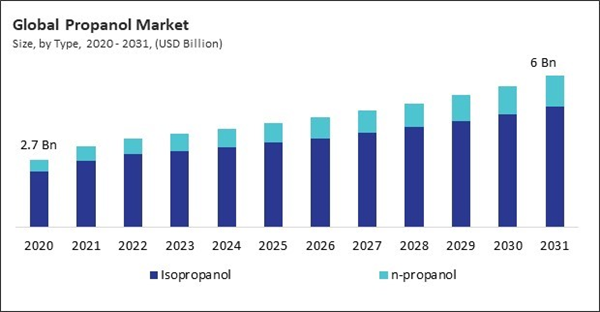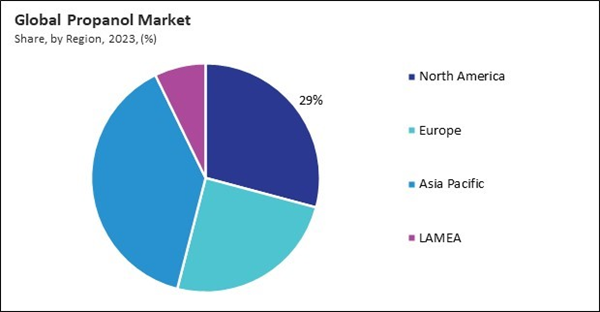The Global Propanol Market size is expected to reach USD6 billion by 2031, rising at a market growth of 6.4% CAGR during the forecast period. In the year 2023, the market attained a volume of 3,171.75 kilo tonnes, experiencing a growth of 18.6% (2020-2023).
The COVID-19 pandemic has heightened awareness of health and hygiene practices, increasing demand for disinfectants, sanitizers, and cleaning agents. Propanol is a crucial component of surface disinfectants and hand sanitizers because of its potent antibacterial qualities. The surge in demand for hygiene products during the pandemic has increased the consumption of propanol-based formulations in North America. Therefore, in 2023, the North America region generated 29% revenue share in the market. In terms of volume, 1,448.36 kilo tonnes of propanol is expected to be utilized by this region by the year 2031.
The rising trend of natural and organic cosmetics in Canada has influenced manufacturers to seek safe and effective solvents. Propanol, known for its purity and safety in cosmetic applications, has benefited from this shift, enhancing its market share. The booming cosmetics sector has prompted companies to invest more in research and development for new products.
Hand sanitizers have become essential for maintaining hand hygiene, especially during public health crises like the COVID-19 pandemic. Propanol, especially in its IPA form, is frequently employed as a primary ingredient in hand sanitizers for its efficient germ and bacteria-elimination properties. The growing awareness of hygiene standards and the importance of infection control in these sectors drives the demand for propanol, thus stimulating growth in its market. Thus, increased focus on hygiene and disinfection propels the market’s growth.
Additionally, Propanol, particularly isopropanol (IPA), is widely utilized as a solvent in the chemical industry for processes such as extraction, purification, and formulation. With the chemical industry experiencing growth in sectors like pharmaceuticals, paints and coatings, adhesives, and personal care products, there is a concurrent rise in the demand for solvents like propanol. As manufacturing activities escalate in these sectors, so does the requirement for propanol, driving growth in its market. Hence, growth in the chemical industry is driving the market’s growth.
However, Petrochemical prices, including propylene and ethylene, are subject to fluctuations influenced by crude oil prices, supply-demand dynamics, geopolitical events, and economic conditions. Since propanol production is closely tied to the availability and pricing of petrochemical feedstocks, volatility in petrochemical prices can directly impact the production cost of propanol. When petrochemical prices surge, propanol production costs increase, squeezing profit margins for manufacturers and potentially leading to higher prices for propanol products in the market. Therefore, fluctuating raw material prices are hindering the growth of the market.
The COVID-19 pandemic has heightened awareness of health and hygiene practices, increasing demand for disinfectants, sanitizers, and cleaning agents. Propanol is a crucial component of surface disinfectants and hand sanitizers because of its potent antibacterial qualities. The surge in demand for hygiene products during the pandemic has increased the consumption of propanol-based formulations in North America. Therefore, in 2023, the North America region generated 29% revenue share in the market. In terms of volume, 1,448.36 kilo tonnes of propanol is expected to be utilized by this region by the year 2031.
The rising trend of natural and organic cosmetics in Canada has influenced manufacturers to seek safe and effective solvents. Propanol, known for its purity and safety in cosmetic applications, has benefited from this shift, enhancing its market share. The booming cosmetics sector has prompted companies to invest more in research and development for new products.
Hand sanitizers have become essential for maintaining hand hygiene, especially during public health crises like the COVID-19 pandemic. Propanol, especially in its IPA form, is frequently employed as a primary ingredient in hand sanitizers for its efficient germ and bacteria-elimination properties. The growing awareness of hygiene standards and the importance of infection control in these sectors drives the demand for propanol, thus stimulating growth in its market. Thus, increased focus on hygiene and disinfection propels the market’s growth.
Additionally, Propanol, particularly isopropanol (IPA), is widely utilized as a solvent in the chemical industry for processes such as extraction, purification, and formulation. With the chemical industry experiencing growth in sectors like pharmaceuticals, paints and coatings, adhesives, and personal care products, there is a concurrent rise in the demand for solvents like propanol. As manufacturing activities escalate in these sectors, so does the requirement for propanol, driving growth in its market. Hence, growth in the chemical industry is driving the market’s growth.
However, Petrochemical prices, including propylene and ethylene, are subject to fluctuations influenced by crude oil prices, supply-demand dynamics, geopolitical events, and economic conditions. Since propanol production is closely tied to the availability and pricing of petrochemical feedstocks, volatility in petrochemical prices can directly impact the production cost of propanol. When petrochemical prices surge, propanol production costs increase, squeezing profit margins for manufacturers and potentially leading to higher prices for propanol products in the market. Therefore, fluctuating raw material prices are hindering the growth of the market.
Driving and Restraining Factors
Drivers
- Increased Focus on Hygiene and Disinfection
- Growth in the Chemical Industry
- Expansion of the Pharmaceutical Industry Globally
Restraints
- Fluctuating Raw Material Prices
- Increasing Competition from Alternative Solvents
Opportunities
- Emerging Applications in Electronics Manufacturing
- Expansion of the Personal Care and Cosmetics Industry
Challenges
- Handling and Storage Challenges
- Emerging Contaminant Concerns
Isopropanol Outlook
The isopropanol segment is further subdivided into direct solvent, chemical intermediate, pharmaceuticals, household & personal care, and others. In 2023, the direct solvent segment procured 32% revenue share in the propanol market. In terms of volume, 1,134.71 kilo tonnes of direct solvent isopropanol is expected to be utilized by the year 2031. This segment's dominance can be attributed to isopropanol's effectiveness as a solvent in various applications, including industrial cleaning, degreasing, and as a solvent in paints and coatings.Type Outlook
Based on type, the market is divided into isopropanol and n-propanol. In 2023, the isopropanol segment garnered 82% revenue share in the propanol market. In terms of volume, 4,169.52 kilo tonnes of Isopropanol propanol is expected to be utilized by the year 2031. Isopropanol is highly versatile and finds applications across a wide range of industries. It serves as a solvent, intermediate, disinfectant, and cleaning agent in pharmaceuticals, cosmetics, personal care, electronics, automotive, and printing industries.Regional Outlook
Region-wise, the propanol market is analyzed across North America, Europe, Asia Pacific, and LAMEA. The Asia Pacific region witnessed 39% revenue share in the propanol market in 2023. In terms of volume, 2,117.90 kilo tonnes of propanol is expected to be utilized by this region by the year 2031. The Asia-Pacific region is a global center for manufacturing across various industries, such as consumer products, electronics, automobiles, and pharmaceuticals. Propanol is widely used as a solvent, cleaning agent, and intermediate in manufacturing processes across these industries.List of Key Companies Profiled
- Exxon Mobil Corporation
- Solvay SA
- BASF SE
- The Dow Chemical Company
- Sasol Limited
- Eastman Chemical Company
- Tokuyama Corporation
- Mitsui Chemicals, Inc.
- Shell plc
- Huntsman Corporation
Market Report Segmentation
By Type (Volume, Kilo Tonnes, USD Billion, 2020-2031)
- Isopropanol
- Direct Solvent
- Chemical Intermediate
- Pharmaceuticals
- Household & Personal Care
- Other Isopropanol Applications
- n-propanol
- Chemical Intermediate
- Direct Solvent
- Other n-propanol Applications
By Geography
- North America
- US
- Canada
- Mexico
- Rest of North America
- Europe
- Germany
- UK
- France
- Russia
- Spain
- Italy
- Rest of Europe
- Asia Pacific
- China
- Japan
- India
- South Korea
- Singapore
- Malaysia
- Rest of Asia Pacific
- LAMEA
- Brazil
- Argentina
- UAE
- Saudi Arabia
- South Africa
- Nigeria
- Rest of LAMEA
Table of Contents
Chapter 1. Market Scope & Methodology
Chapter 2. Market at a Glance
Chapter 3. Market Overview
Chapter 4. Global Propanol Market by Type
Chapter 5. Global Propanol Market by Region
Chapter 6. Company Profiles
Companies Mentioned
Some of the key companies in the Propanol Market include:- Exxon Mobil Corporation
- Solvay SA
- BASF SE
- The Dow Chemical Company
- Sasol Limited
- Eastman Chemical Company
- Tokuyama Corporation
- Mitsui Chemicals, Inc.
- Shell plc
- Huntsman Corporation
Methodology

LOADING...










